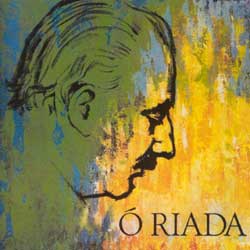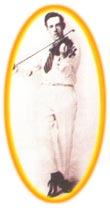Christina Roden asks the impossible question:
"What Is Irish Traditional Music?"
 Sean Ó'Raida |
The music/dance stage epic "Riverdance" (video - Columbia Tristar; soundtrack - Celtic Heartbeat) has been hugely effective in bringing Irish culture into the mainstream. Even if Bill Whelan's score harbors occasional recollections of "Classical Gas" or "MacArthur Park", it is mostly idiomatic, and has delighted millions who never previously gave Ireland, or Irish music, a single thought. Michael Flatley's revolutionary choreography also remains an astounding achievement, liberating Irish step dancing from its pipe-up-the-posterior vertical stiffness and making it sexy, although self-parody has long since set in. The question is, will the hordes who adored this extravaganza and its overwrought rival, "Lord Of The Dance", be moved to find out about where they came from?
Some will and some won't, but the "Riverdance" phenomenon is symbolic of Ireland's present-day prosperity, and the music scene there is burgeoning as never before. Musicians from emigrant communities are exchanging influences with native-born Irish players, and new branches of the ancient bardic family tree are blossoming in the open air. Irish music is more popular on the world stage than ever before. It is ubiquitous in advertising jingles, spacey new age meanderings, and on film soundtracks. Unfortunately, as the market becomes flooded with wannabes and clumsy attempts by stars from other genres who are dying to get in on the current vogue, many excellent bands who are keeping the faith getting lost in the shuffle.
 Michael Coleman |
This being said, the first thing to realize about authentic Irish instrumental music is that much of it is meant for dancing. The tunes range from four-to-the bar reels to various types of jigs, which can be either sprightly or stately. Most jigs are in 6/8, but there is an older style known as a "slip jig" that trips along in a 9/8 time signature. Dances from abroad, such as waltzes and polkas, have been gradually transformed into recognizably Irish versions. Scandinavian tunes turn up, although whether these date from the early Viking invasions of Ireland or from later encounters is hard to prove. Most dance tunes, wherever they originated, favor modal tuning and a circular construction that allows for endless repetitions and smooth transitions between selections. There is also a sizable repertoire of instrumental "slow airs", which are strictly for reflective listening. Aside from giving the dancers a chance to catch their breath, they are wistful, tender microcosms of race memory.
The instruments vary relatively little from ensemble to ensemble, and may be either electric or acoustic, but an astonishing array of sounds are drawn from them. Fiddles, wood flutes, tin whistles, and squeezeboxes are commonly used, augmented by guitars and by the bouzouki, a plangent-toned Greek lute that has become very popular with Irish musicians. The bodhrán, a hand-held goatskin wooden frame drum, marks the time. The whole is sometimes embellished by the plaintively reedy sound of the uilleann pipes, a small bagpipe peculiar to Ireland. The pipes are an important solo instrument, especially for "slow airs", which are among the oldest surviving types of Irish music. The clarseach (Irish harp), in a modern nylon or gut stringed incarnation, or in the more antique metal-stringed version, has made a strong come-back from nearly total obscurity. It is once again a living symbol of Ireland and its music.
The present fascination with traditional music and songs sung in the Irish language actually dates from the mid-1960's, when the composer-arranger-musicologist Sean Ó'Raida began a grass-roots Celtic revival. Until he took action, most popular songs in Ireland were sung in English, and the lyrics generally spoke about the forthright pleasures of the jug and romantic vicissitudes or else keened over deceased Republican heroes and incited insurrection. The fragile Bardic strain turned up now and again, but most Gaelic music languished outside of the popular imagination, in Irish-speaking enclaves (gaeltachts) in the West and South. O'Riada also rescued the Irish harp from oblivion, although in a gut-stringed version that the Bards would hardly have recognized, and introduced the Bodhrán (hand-held goatskin frame drum) into general use. His own ensemble was called Ceoltoiri Chualann, and out of it came the core membership of Ireland's best-known traditional music group, The Chieftains. By the end of his short life, Sean Ó'Raida had reclaimed Ireland's soul and his death was marked by national mourning. His recordings, many of which are on the Gael-Linn label, are now considered national treasures. Mise Eire (Shanachie), is an atmospheric example of his work.
Next: The Fiddle
Images courtesy of Gael Linn Records